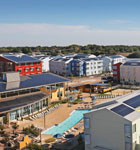SCENE
Davis, California, is the quintessential college town. It has about 70,000 people. It’s mostly liberal. And it’s more than bike-friendly. The town’s primary employer is the University of California at Davis, an institution whose mission is to advance the human condition by improving quality of life. With a campus more than 100 years old and a self-proclaimed “global impact,” the leadership at UC-Davis is well aware that sustainability can help drive the school’s mission.
In 2004, UC Davis put out an RFQ for a master developer to develop 130 acres of mixed-use property, an on-campus site called West Village that would include housing and student facilities. Carmel Partners, a 20-year-old San Francisco-based real estate firm responded as a joint venture with its partner Urban Villages of Denver and were awarded the project in 2005. Their vision: create the largest planned net-zero-energy community in the United States.

When done right, elements like deep overhangs, sunshades, and sloped roofs can be aesthetic as well as functional.
SETUP
There were three core goals for the UC-Davis West Village project: First, expand housing options to help the university with its student and staff retention and recruitment efforts. Second, focus on quality of place at all scales of development, from the interiors to the public spaces. And third, emphasize environmental responsiveness. The last required the team to rethink various design elements: the type of plants used by SWA Group in landscaping, for instance, or the development’s rigorous exterior sun-shading system and the buildings’ orientation.

The residence halls feature an eye-catching grid of fixed exterior sunshades that minimize solar heat gain.
Carmel Partners hired two architectural design firms: MVE Institutional of Irvine for the bulk of the student housing and Studio E of San Diego for the mixed-use buildings. It used its in-house construction company for the build out, while Urban Villages played a key role in helping to work through the entitlements with the university. Cunningham Engineering handled civil engineering and D&D Cabinets supplied all the cabinetry.
STRATEGY
Though not even asked by the university to do so, Carmel Partners achieved its goal of making West Village a net-zero community. It focused on energy efficiency by upgrading building insulation, using a super-efficient HVAC system, installing high-performance low-E glass and Energy Star-rated appliances, and adding fluorescent lighting in units to bring down the energy load. Oversized operable windows on both sides of the buildings generate cross breezes and allow for passive cooling. These and other techniques helped make the buildings “50 percent more efficient than the California Building Code,” according to Nolan Zail, senior vice president of development of Carmel Partners.
Solar panels capable of generating four megawatts of electricity were installed on south-, east- and west-facing rooftops, as well as over parking lot structures. The system, from Sunpower, will produce the community’s remaining energy need, reducing energy used from the grid to zero. Just to cap it off, the three-story apartment buildings all are LEED Platinum-certified.
Phase I of the $300 million development opened in fall 2011 and included 850 student beds in 315 apartments, 42,000 square feet of commercial retail space, and a 16,000-square-foot student-amenities building. Phase II, planned for fall 2012, will included 630 beds in 192 units; Phase III, scheduled to open fall 2013, will add 500 more beds and 155 units.
Tani Elliott, Carmel Partners’s project manager, says that, altogether, “UC Davis West Village will house approximately 3,000 students, faculty, and staff in 662 apartments and 343 single-family homes, and will have 42,500 square feet of commercial space, and the student recreation center.”


